How to Grow Blueberries for Beginners
If you have been wanting to add fruits to your backyard garden, this guide is for you. You’ll get all the details on How to Grow Blueberries for Beginners from start to finish. This will give you everything you need to add a few berry bushes to your backyard setup.
Bookmark this helpful guide and add it to your gardening 101 library!
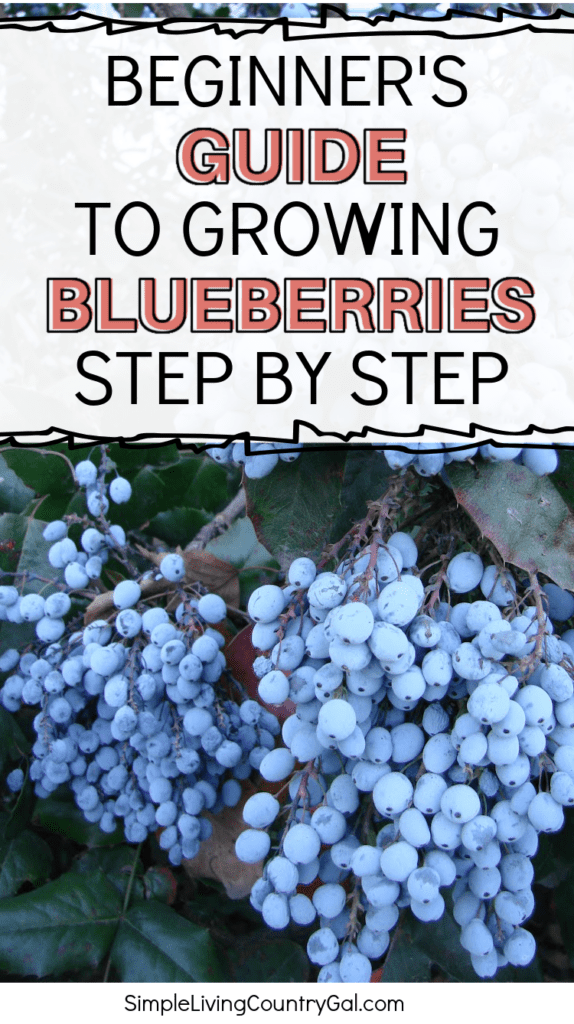
Not only do blueberries provide a tasty and healthy addition to your family’s diet, but they also give a pretty look to your home and garden. There’s just something about that blue hue given by a row or two of blueberry bushes that encompasses the goodness of summer.
Blueberries are perfect for gardeners looking to add fruits to their backyard setup. Blueberries are easy to grow and have a slow to moderate growth rate. They grow in bushes that do well in the ground or even in pots to add color to your deck or patio.
Blueberries come in a variety of fruiting and flowering shrubs to offer you a few different options for both taste and visual appeal. Some other fruit shrubs in the blueberry family include lingonberries, cranberries, huckleberries, and bilberries.
Blueberry bushes have oblong, pointed leaves that turn a bright red in the fall. Flowers will bloom in small, white bell shapes in the late spring and become edible berries as they change from green to deep blueish purple.
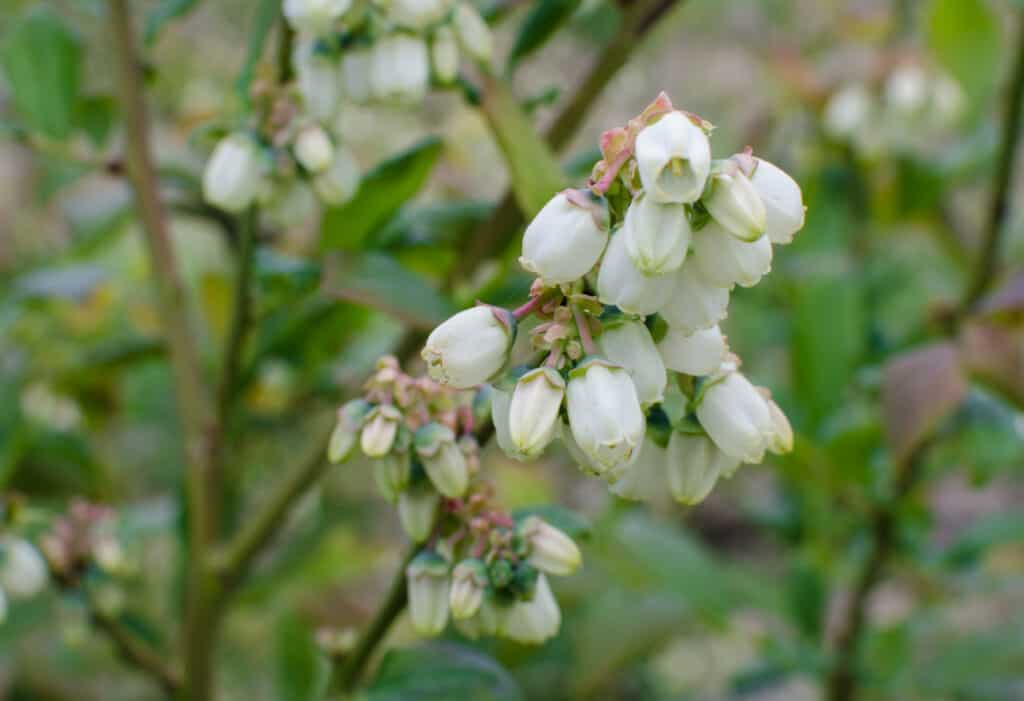
Blueberry Types
There are four main types of blueberry plants to consider, each with its own varieties.
Highbush
This shrub grows to about six-feet and is best for zones 4 through 7. It is the most common type of blueberry and the most productive. Highbush varieties that are suited for cold winters include Bluecrop, Blueray, Jersey, Meader, and Herbert. If you’d like to grow large berries, varieties best for this are Bluecrop, Berkeley, Blueray, Darrow, Coville, and Herbert. There is also a highbush variety that produces beautiful pink berries called Pink Lemonade.
Southern Highbush
This type can be hard to grow, but several varieties are popular in southern states because they’re more comfortable in warmer temperatures. Southern Highbush are shorter bushes, only growing about 3 to 6 feet tall and about 4 to 5 feet wide; they are best grown in zones 7 through 10. Varieties include Emerald, Windsor, and Springhigh.
Lowbush
This type is best suited to colder climates and can be grown as far north as zone 3. Instead of growing in a bush-like formation, they only grow about a foot tall and spread out in a creeping pattern. Lowbush is native to northeastern United States and southern Canada. It produces berries with a waxy covering that make them look more gray in color. These are often considered wild blueberries and don’t have many cultivators available.
Half-Highbush
This is a newer blueberry, breed and developed by crossing highbush and lowbush species. Most of them grow to 18 to 48 inches high and are typically less sweet than highbush varieties. They are perfect for pies and jams. Some varieties include North Country, Northblue, and Northland.
Rabbiteye
This type is mostly grown in the southeastern part of the United States. It can grow as high as 15 feet and requires two or more varieties to pollinate correctly. This type is perfect for zones 7 through 9 and varieties include Woodard, Brightwell, and Powderblue.
Blueberries vs. Huckleberries
These berries are sometimes confused with each other as they come from the same species and the fruits look similar. Huckleberries tend to more tart than blueberries though and their seeds are harder when you bite into them.
Seed, Bulb, or Plant?
Although blueberry bushes can be grown from seeds, your best option is to grow them from already established bushes that are 2 to 3 years old. These can be purchased from local or online nurseries and will speed up the amount of time it takes to produce a good harvest. Planting from seeds, you can expect to wait 6-7 years for a full harvest but in planting an established bush, you should receive a small harvest within a year or two and a full harvest within 3-4 years.
When selecting bushes, choose bare-root plants that are not more than 3 years old. Older plants can suffer from transplant shock which can slow down the production of the berries for a couple of years.
Bushel and Berry Vaccinium x Perpetua (Blueberry) Edible-Shrub, 2-Size Container, Double Fruiting


What You Need to Grow Blueberries
You’ll want to start your blueberry bushes in early spring and plant them in an area with full sun and acidic soil. Be patient, you won’t see a moderate harvest for about three growing season and a full harvest will take about six years.
When to Plant Blueberries
Blueberry bushes are best planted in early to mid-spring when the soil is warm enough. If you live in a hardiness zone of 6 or higher, they can also be planted in late fall before the first frost.
Temperature
Temperature requirements will vary based on the species you choose. High bush varieties prefer more humidity and a cold winter climate but varieties that are bred for Southern gardens won’t tolerate freezing temperatures. Most varieties need to be protected from dry winds.
Sun
Blueberries need full sun, at least 6 to 8 hours of direct sunlight on most days, in order to grow and produce fruit.
Soil
Blueberries need acidic soil with a pH between 4.0 and 5.2. They also do well when organic matter is added into the soil. If your soil has heavy clay, use raised beds or containers for planting where you can control the composition of the soil and the pH level. Sandy soil is preferred to dense clay soil.
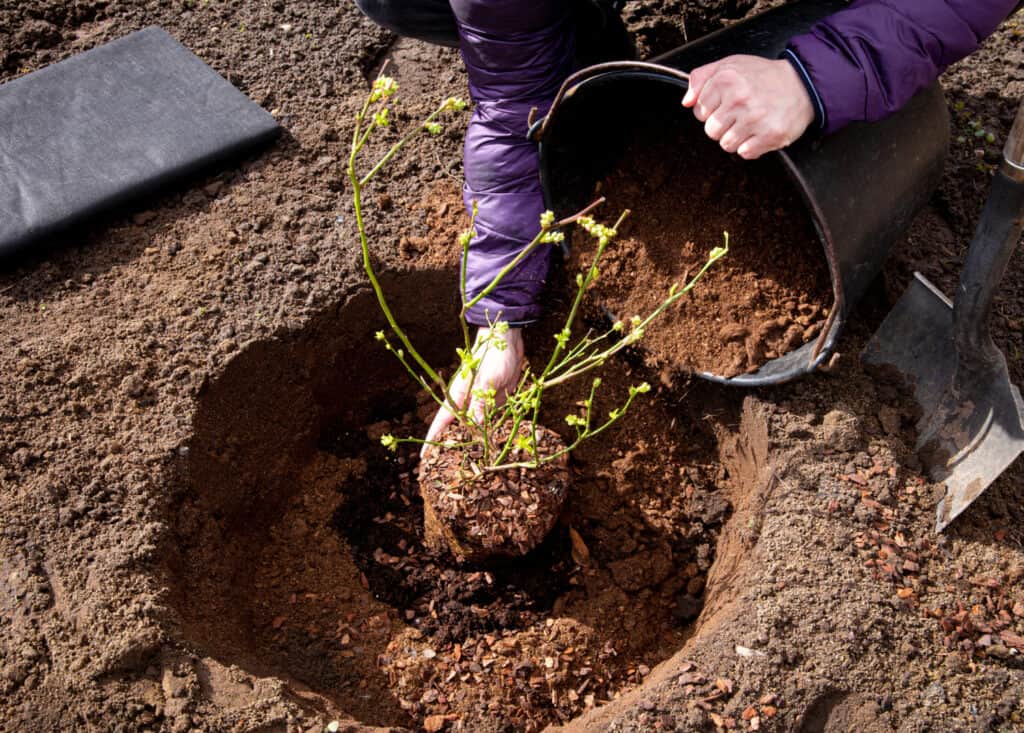
Water
Be sure your blueberry bushes get a deep watering at least once a week. They are shallow rooted plants and need at least a couple inches of water every week, more in a dry spell. The soil should remain moist but not puddled. During dry, hot summer months, consider watering 2-3 times a week.
Fertilizing
Avoid fertilizing during the first year of growth as the roots are sensitive until the plants are well established. In the second year and beyond, you can feed them based on two indicators: when the flower buds begin to open and again when the berries start to form.
Be sure to remove weeds regularly so the soil nutrients aren’t being absorbed by weeds.
Ammonium sulfate is a preferred fertilizer to aluminum sulfur, which lowers the pH. You can use any fertilizer made for acid-loving plants, including blueberry and azalea food. You can also use fertilizer applied directly to the leaves or one made for fertilizing the soil. Organic fertilizers like compost, manure tea, and fish emulsion are also good choices.
Organic Fish Fertilizer – Liquid Fish Emulsion Food for Plants, Flowers, Fruits & Vegetables – 2-3-1 NPK – Made from Sustainably Sourced Hydrolyzed Fish (1 Gallon)

Support
Blueberries grow in bushes and stay just a few feet off the ground, so they don’t require any support system.
How Much to Plant
The average life of a blueberry plant is about 20 years and they will flourish more after the 5th or 6th year if they’re properly cared for. With this being the case, 2 plants per person in your household will provide an abundance of berries all season long once they reach their full maturity.
How Long Do Blueberries Take to Grow?
While blueberry bushes will produce a few berries within the first year, they won’t reach their full maturity until they are 5-6 years old. Expect a very small harvest in the first 5 or 6 years and an abundant harvest after that.
GREEN MOUNT Watering Wand, 24 Inches Sprayer Wand with Superior Stainless Head, Perfect for Hanging Baskets, Plants, Flowers, Shrubs, Garden and Lawn




How to Plant Blueberries
Choose established bushes that are at least 2 years old but not older than 3 years old; anything older will suffer transplant shock and will slow down the production of berries for a few years. Plan on planting in early to mid-spring. If you live in Hardiness Zone 6 or higher, you can plant as late as fall.
Find a spot that receives full sun at least 6 to 8 hours a day and is sheltered from strong winds. Avoid areas that are close to tall trees or shrubs as they can block the sunlight or compete for nutrients and moisture from the soil.
Make sure the site has good drainage. If the soil is too hard, you can mix in peat moss to keep it loose and well-drained. This will also improve the soils acidity. Containers are also a good option if they receive sufficient sunlight and moisture.
Give blueberry bushes plenty of room to spread out, planting them about 4 to 5 feet apart. If your planting several rows, plant them at least 9 to 10 feet apart to provide plenty of room for moving around them when you harvest.
When planting bare-root bushes (preferable), spread the roots out in the prepared hole then cover them with soil making sure the root ball is no more than a half inch below the soil surface. For container planting, plant them at the same depth that they were in the nursery pot.
Growing Tips for Blueberries
· After planting, add a layer of mulch. Evergreen wood chips, pine needles, or sawdust will improve the soil’s acidity.
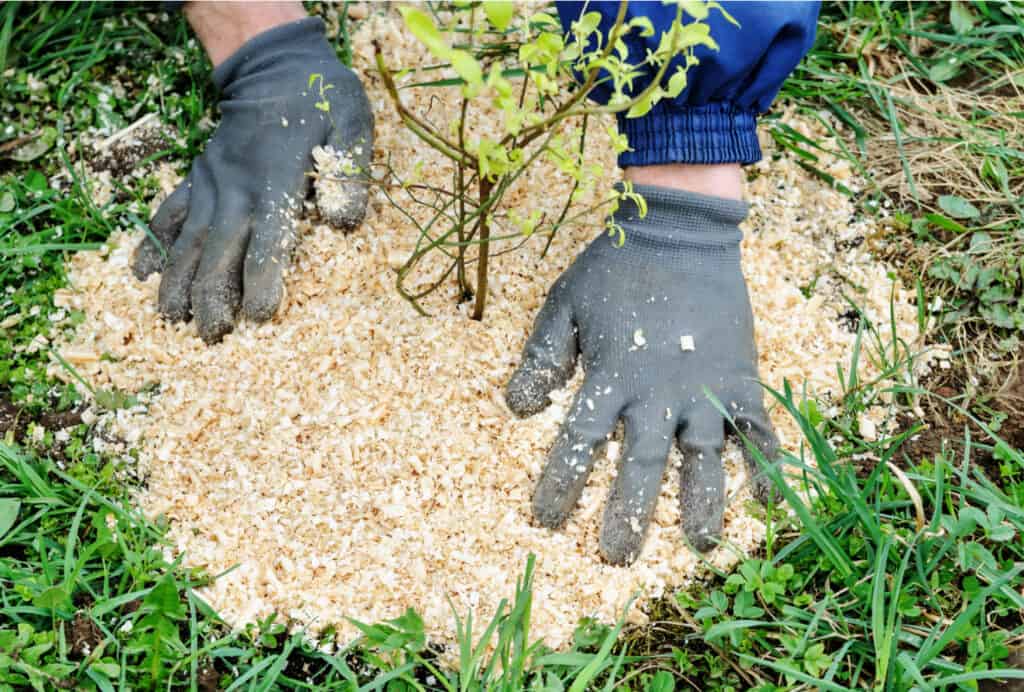
· For the best pH level, plan to amend the soil in the season before planting. This will give the soil proper time to adjust.
· Garden sulfur or aluminum sulfur can be mixed into the top six inches of soil to lower the pH if necessary.
· If you’re not sure about your soil, you can take a sample to your local garden center for testing and they can help you determine how much sulfur you’ll need to add.
More Soil Care Resources:
- Turn Your Crappy Soil into a Lush Garden
- How to Compost in Your Own Backyard
- Soil Prep Tips for a Summer Garden
· Continue to check and amend the soil periodically as it can revert back to it’s original pH over time.
· Yellowing of leaves is common and although this is usually a sign of iron deficiency, it’s probably not due to a lack of iron in the soil. Most likely it’s a sign that the soil pH is to high and the plants can’t access the iron available in the soil. Test the pH level of the soil and adjust as need be.
· Blueberry bushes are self-pollinating but for best results, plant a few bushes near each other, preferably at least 3. The diversity in the bushes will provide both a higher fruit yield and larger berries. When planting a few varieties together, make sure the bloom simultaneously to ensure cross-pollination.
How to Harvest Blueberries
Blueberries are usually ready to harvest between June and August when the berries turn from green to blueish purple. Once they turn purple, leave them on the bush for another few days, no more than a week, before harvesting. This will make them sweeter. Most plants will start to produce fruit by their third year. Mature bushes will produce about 8 quarts of berries per bush. Planting more bushes a few months apart will allow you to extend your harvest.
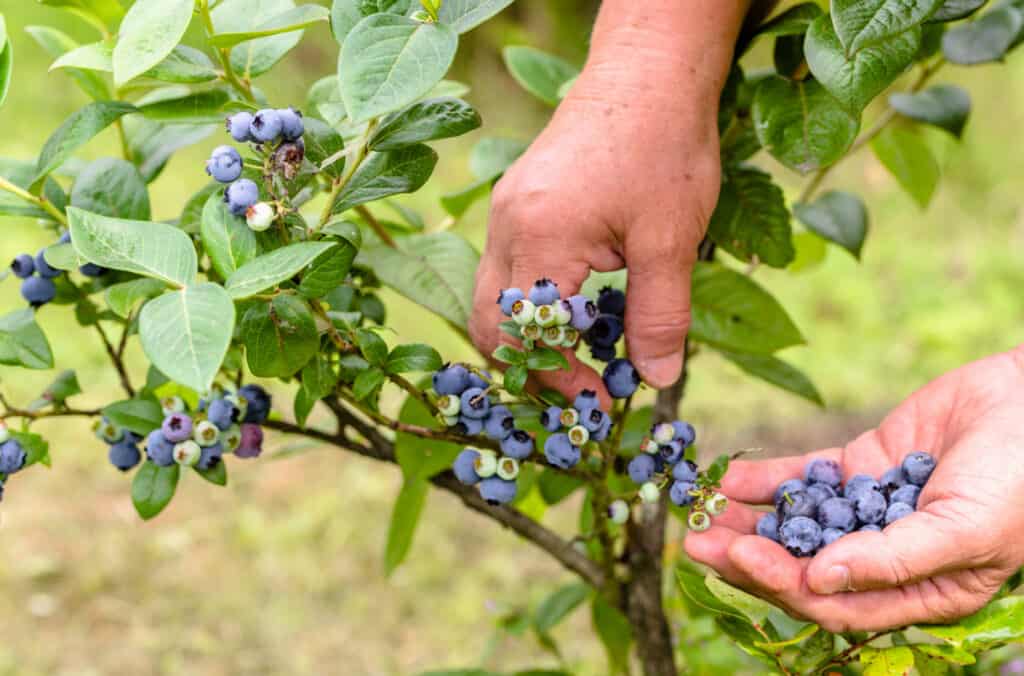
The only reliable way to know if they’re ready is to taste them. Ripe berries will easily come off the stem.
For easiest harvesting, hold a container under the blueberry clusters and gently pick them off, dropping the fruits into the container. Refrigerate them, unwashed, as quickly as possible.
How to Store Blueberries
Blueberries will usually last in the refrigerator for about a week. It’s best not to wash them until you’re ready to use them to help preserve them longer. They can also be washed and frozen for 6 to 12 months.
Diseases and Pests to Watch Out For
One of the biggest problems you’ll have with growing blueberries is keeping birds away. To help deter them, place bird netting over your bushes or use a scarecrow.
Common insects include scale, cherry and cranberry fruit worms, blueberry tip borer, and plum curculio. Find out if these pests are common in your area and, if so, spray deterrent on the bushes.
Powdery mildew and rust can also be a problem but they can be treated with neem oil.
For best results, plant genetically resistant varieties, give your plants plenty of space for air circulation, plant them in full sun, and clean up any plant debris. Replacing mulch annually can also help to keep fungal spores from developing.
Blueberries are one of the easiest plants to grow and provide a bounty of fruit once they are fully matured. And since they grow well both in your garden and in pots, they can be planted in any size area. They also make great landscaping around your home.
More How to Grow Resources:
How to Grow Blueberries
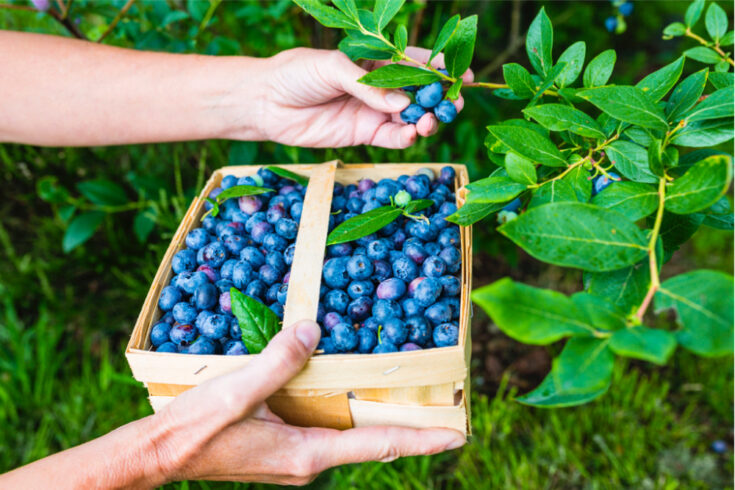
How to grow sweetest blueberries in your own backyard that are great for mixing into fruit smoothies or jsut a light snack. Get planting and care tips so that you are able to grow the best blueberries this year. How to grow blueberries step by step, from planting to harvest.
Materials
- Blueberry Seeds or Bushes
- Water
- Mulch (wood chips, pine needles, or sawdust)
- Garden Netting (Optional)
Tools
- Garden or garden containers
- Rake
- Shovel
Instructions
- In early to mid-spring, plant seeds or transplant bushes in a spot with 6-8 hours of sunlight per day.
- Each seed/bush needs to be planted about 4 to 5 feet apart. If planting multiple rows, plant each row 9 to 10 feet apart.
- Water ever couple days with an average of 1 inch of water per week.
- A few days after the berries turn purple, they are ready for harvest.
- Blueberries can be stored in the refrigerator for about a week. Wait to wash the fruit until just before use.
Notes
- Blueberry bushes are self-pollinating but for best results, plant a few bushes near each other, preferably at least 3. The diversity in the bushes will provide both a higher fruit yield and larger berries. When planting a few varieties together, make sure the bloom simultaneously to ensure cross-pollination.
- Yellowing of leaves is common and although this is usually a sign of iron deficiency, it’s probably not due to a lack of iron in the soil. Most likely it’s a sign that the soil pH is to high and the plants can’t access the iron available in the soil. Test the pH level of the soil and adjust as need be.
- While blueberry bushes will produce a few berries within the first year, they won’t reach their full maturity until they are 5-6 years old. Expect a very small harvest in the first 5 or 6 years and an abundant harvest after that.
Recommended Products
As an Amazon Associate and member of other affiliate programs, I earn from qualifying purchases.
-
PERFECT PLANTS Premier Blueberry Live Plant, 1 Gallon, Light Green
-
4 Packs Garden Plant Netting Blueberry Bushes Protection Netting Covers Bags, Tomato Fruit Trees Protective Cover Garden Plant Netting Covers Bags Plant from Insect Bird Eating 4.92x3.3 FT
-
Shovel for Digging,Round Shovel, Garden Tool with D-Handle, 41 Inches in Overall Length, Wooden Handel Garden Shovel,Beach Shovel, Car Snow Shovel
-
500+ Blueberry Seeds for Planting

















Thank you so much for sending me all these “How to” manuals! Absolutely, perfect and so helpful.